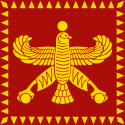
Back عابر-ناري Arabic Сатрапія Зарэчча Byelorussian Ебер-Нари Bulgarian Satrapia de Síria Catalan Ebir-Nari German Eber-Nari Spanish Eber-Nari Basque عبر-ناری (ساتراپی هخامنشی) Persian Transeuphratène French עבר נהרה HE
| Eber-Nari | |||||||||
|---|---|---|---|---|---|---|---|---|---|
| Satrapy of the Achaemenid Empire | |||||||||
| c. 539 BC–c. 332 BC | |||||||||
|
Standard of Cyrus the Great | |||||||||
| Historical era | Axial Age | ||||||||
| c. 539 BC | |||||||||
| c. 332 BC | |||||||||
| |||||||||
Eber-Nari (Akkadian), also called Abar-Nahara (Aramaic) or Aber Nahra (Syriac), was a region of the ancient Near East. Translated as "Beyond the River" or "Across the River" in both the Akkadian and Aramaic languages, it referred to the land on the opposite side of the Euphrates from the perspective of Mesopotamia and Persia. In this context, the region is further known to modern scholars as Transeuphratia (French: Transeuphratène). Functioning as a satrapy, it was originally administered by the Neo-Assyrian Empire before being absorbed by the Neo-Babylonian Empire and then by the Achaemenid Empire. During the Greek conquest of Persia, Eber-Nari was, like the rest of the Achaemenid Empire, annexed by the Macedonian Empire of Alexander the Great. It was later dissolved by the Seleucid Empire, which incorporated it into Syria, along with Assyria.
In the "DSf" Achaemenid royal inscription, the Akkadian Eber-Nari is referred to as Athura or Athuriya in Old Persian and as Aššur in Elamite.[1][2] The Targum Onkelos, an Aramaic translation of the Torah, lists Nineveh, Calah, Reheboth, and Resen as being in the Athura jurisdiction.
- ^ John, Boardman (1991). The Cambridge Ancient History: pt. 1. The prehistory of the Balkans; and the Middle East and the Aegean world, tenth to eighth centuries B.C. Cambridge University Press. pp. 433–434.
In the Babylonian version of the text the transportation to Babylon is credited to the people of eber nari, showing that to the scribe or scribes of these inscriptions the Babylonian equivalent of Old Persian Athura was eber nari...
- ^ Shawn Tuell, Steven. The Law of the Temple in Ezekiel 40-48. Scholars Press. p. 158.
Moreover, in a bilingual building inscription of Darius at Susa, the Old Persian kara hya Athuriya ("people of the Assyrians") is rendered in Akkadian as sabe sa eber nari ("people of eber nari")...
